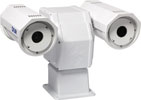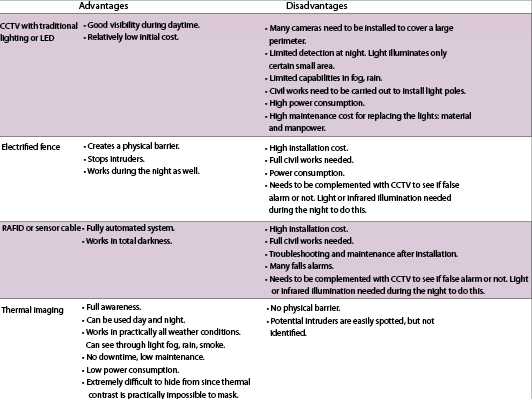

As CCTV systems become more advanced, the security industry will move to raise the standard for all CCTV installations to be designed for 24-hour surveillance, not just daytime operation. To be truly secure, a site must be protected day and night.
A number of tools are available to help detect potential intruders in the dark. Often different technologies are combined to create a secure perimeter. Fences can be complemented with CCTV systems with or without active infrared illumination or old-fashioned light bulbs, radio frequency intruder detection (RAFID) systems, thermal imaging cameras and/or walking patrols.
Whatever solution or technology is chosen for securing an area, they all have their advantages and disadvantages and some are more expensive than others are. To get a full picture of the total cost of ownership (TCO) for a certain solution, not only the initial installation cost, but also the maintenance cost needs to be taken into account. Some solutions consume a lot of power and need a good supply of spare parts. Environmental and energy consumption issues are today high on the global agenda. Given that $1 from every $5 spend globally is used on lighting, and much of this is spent on inefficient and unnecessary lighting, particular attention should be given to this area. The focus to save energy by looking at running costs will continue to increase. Local authorities and private industries are all looking at methods to save energy costs and lighting is one area due careful attention.
Quite a number of technologies are available to help detect potential intruders in the dark before they become a real hazard. Let us compare some of them:
CCTV combined with traditional lighting
CCTV systems have been an effective tool for security and surveillance applications. However, just like the human eye, CCTV cameras do not see much in total darkness. So in order to detect intruders at night they are often complemented with traditional lights. Although some bulbs (fluorescent lamps, HID lamps) are more efficient than others are, the operational cost is very high. Light can only penetrate a certain distance and completely illuminating an area so that it can be kept under surveillance of CCTV cameras, is not always possible. Powering and maintaining the lights can even be more costly.
CCTV with traditional lamp lighting requires lamp replacement every 2000 to 4000 hours or about every 8 months. There is significant labour and material cost associated with lamp replacement.
Light pollution is a global problem caused by inefficient, intrusive and unnecessary use of artificial light. Symptoms include glare, clutter over-illumination and sky glow. Light pollution is an increasingly hot political topic given recent international government legislation to control and punish light pollution. In some locations, light is also considered too intrusive.
Furthermore, lighting essentially lays out a route of attack for intruders, creating shadows in which they can hide undetected.
CCTV combined with LEDs
Compared to any bulb, LEDs provide significant savings on electrical consumption. LEDs also provide long life performance with little ongoing maintenance costs. Infrared illumination with LEDs, sometimes also called active infrared, beams infrared radiation into the area in front of a camera. The LEDs are often placed around the lens of the camera.
LED illumination is compromised by limited range performance. Higher power LED illumination has its drawbacks in that moisture such as mist and fog, or rain on objects causes reflection of the infrared illumination back into the camera, which causes the shutter to close resulting in loss of important details in darker scenes.
Electrified fences
In order to keep intruders out of certain areas fences can be constructed. To further increase security, fences can be equipped with sensors that generate an automatic alarm when someone touches the fence. Or they can be electrified, to keep intruders away.
In all cases, fences need to be complemented by other technologies such as CCTV cameras or walking patrols in order to see what is happening around the fence.
Radio frequency intruder detection (RAFID)
The simplest description of RAFID is to consider a system using two specially designed cables – one transmitting a radio wave, while the other receives that wave. Changes in the amount of signal passing between the transmitter cable and receiver cable are analysed by a signal processor. If the amount of signal changes, this means that someone or something is between the two cables and an alarm will go off. Due to the difference in the signal strength, the system can detect whether these changes are due to the presence of a human or a small animal.
Note that in many cases CCTV cameras still need to be installed in order to see what is generating a real, or false, alarm.
Thermal imaging
A new tool for seeing in total darkness, in the most diverse weather conditions is thermal imaging. Thermal imaging is the use of a thermal imaging camera to ‘see’ thermal energy emitted from an object. Thermal imaging cameras produce images of invisible infrared or heat radiation. Based on temperature differences between objects, thermal imaging produces a crisp image on which the smallest of details can be seen. They work both during the day and at night.
Most FLIR Systems thermal imaging cameras contain an un-cooled Vanadium Oxide detector. Not only does it produce excellent quality thermal images, since it contains no moving parts, it needs no maintenance. Thermal imaging technology requires no additional lighting or illumination and has no regular maintenance costs.
Deciding which technology to use
Security managers are more familiar with certain technologies than with others. Before making a final decision about which technology will be implemented to secure a perimeter at night, it is a good idea to have a look at the advantages and disadvantages of each technology.
The table tries to summarise the different technologies and their advantages/disadvantages.
Comparing technologies and looking at the benefits each one has to offer is only a first step. Although it already gives a good idea about each technology, the real cost needs to be calculated in order to make a final decision.
Not only does the initial purchase of the system need to be considered, the TCO needs to be calculated. For example, many people do not take into account the electricity consumption of an installation when deciding which technology to install.
Compare the TCO for thermal imaging cameras versus CCTV with IR illumination and lighting by taking an example 1km x 1km perimeter around an industrial facility and comparing the costs of implementing each solution. You will find the thermal solution to be more cost effective when taking into account the added setup costs and civil work associated with traditional CCTV installations. Far fewer thermal cameras are required than traditional CCTV cameras to cover the same distances.

Conclusion
Although all technologies have advantages and disadvantages, a small calculation makes it clear that thermal imaging is a very good and a very cost effective solution for protecting a perimeter. More so if this perimeter, like in practically all cases, also needs to be protected during the night and under all weather conditions.
Although a thermal imaging camera is more expensive than a CCTV camera, fewer cameras need to be deployed to cover the same area. The civil works that need to be carried out is minimal; in some cases the cameras can even be mounted on existing structures. Furthermore, since thermal cameras produce a clear image in the darkest of nights, no complementary technologies like light or infrared illuminators need to be installed. Not only does this limit the amount of civil work that needs to be carried out but it also reduces the maintenance costs.
Thermal imaging cameras also generate fewer false alarms when used with motion detection or video analytics than CCTV cameras do. Although thermal imaging cameras are more expensive than CCTV cameras at initial purchase, they are often not only the best, but also the most cost-effective solution.
For more information contact TeleEye (South Africa), +27 (0)11 557 9200, www.TeleEye.com
| Tel: | +27 11 557 9200 |
| Email: | [email protected] |
| www: | www.gothermal.co.za |
| Articles: | More information and articles about GoThermal (TeleEye) |

© Technews Publishing (Pty) Ltd. | All Rights Reserved.